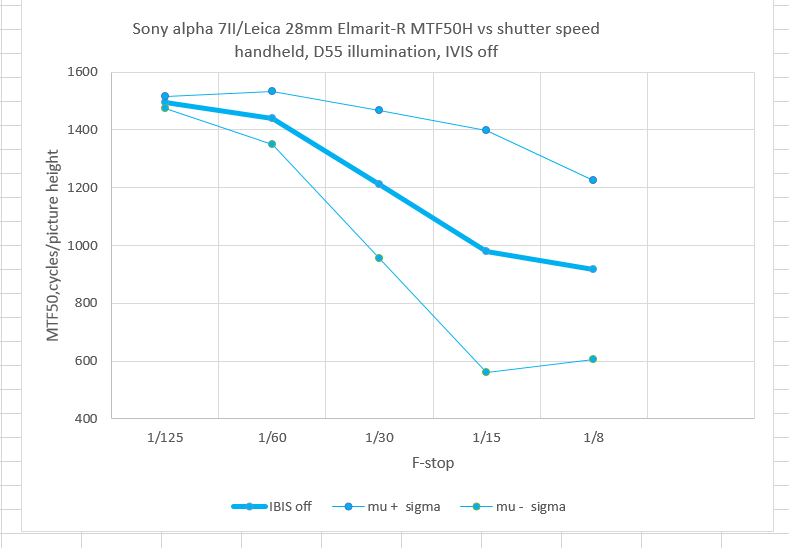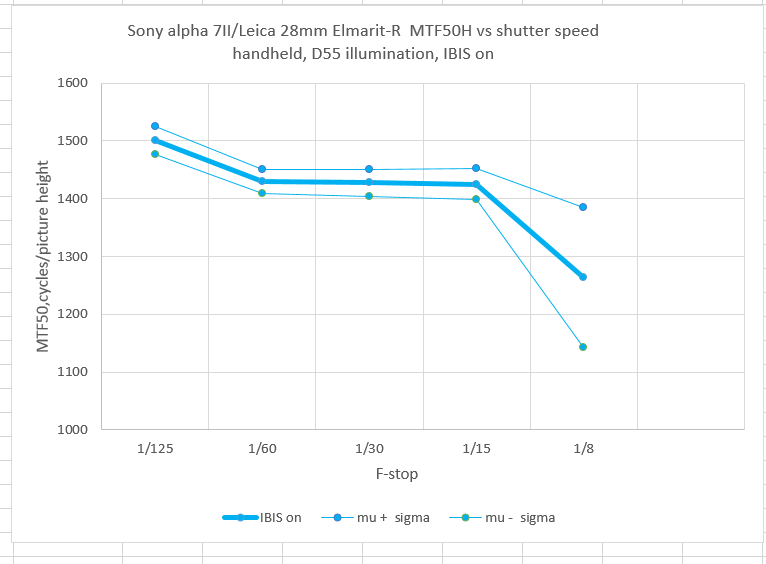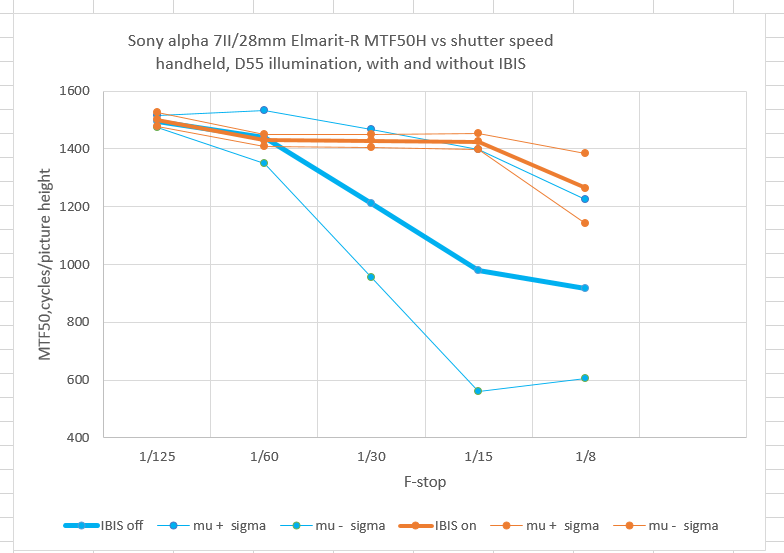A reader asked if I’d test the in-body image stabilization (IBIS) on the Sony alpha 7II with a shortish lens, to bookend the testing I’ve done previously with a 180mm Apo-Telyt and the Zony 55mm FE. I picked the Leica 28mm f/2.8 Elmarit-R, which has shown strong sharpness in previous testing. You won’t find the acronym IBIS in and Sony literature; they call the feature SteadyShot.
I employed the following protocol:
- The camera: the Sony a7II.
- The lens: the Leica 28mm f/2.8 Elmarit-R, with a Novaflex R to E adapter.
- The target: Imatest slanted edge with Siemans star for focusing.
- No filter.
- The lighting: a single Fotodiox LED-200WA-56 daylight balanced variable-output flood.
- ISO set to 400, f-stop set to 8, to minimize the effect of manual focusing errors.
- Focusing manually at f/2.8, using the magnifier with IBIS on (even at 28mm, this makes a difference). The focus point as a Siemens star on the target.
- Drive set to single
- EFCS on
- Manual exposure mode.
- Hold the camera in the “Pete Souza” grip: left palm under base, left fingers bracing the underside of the front part of the lens, elbows against chest.
- Exposure protocol: LED light to full, shutter to 1/125 second, make 16 exposures, turn the light down a stop, make 16 exposures… until you get to 1/8 of a second.
- Develop in Lightroom 5.7.1 with standard settings.
- Crop, export as TIFFs, analyze for horizontal edge and vertical edge MTF50 in Imatest.
- Export the results to Excel, crunch the stats, and graph.
First, with IBIS off, looking at the horizontal edges:
Then, with IBIS on (note the vertical axis is different):
And, finally, with both of the results on the same graph:
The heavy lines are the average,, or mean, values, for which the mathematical symbol is mu. The light lines are the mean plus and minus the standard deviation, or sigma, of the measurement set, and provide an estimate of repeatability.
In the graph with both sets of curves on it, the blue lines are with IBIS off, and the orange ones are with it on. The thick lines are the average ofthe MTF50s for each set of 16 images, and the thin lines are the average plus and minus one standard deviation. My take is that IBIS is at least as effective for short lenses than for long ones.
A few specifics:
- As with the longer lenses, the most confidence-inspiring thing about IBIS is not how much it helps the average image, but the huge improvement in the spread of the results.
- The average image is improved by about two stops.
- The average minus one sigma image is improved by about two and a half stops.
- With IBIS on, the tightness of the standard deviation is almost as good at 1/15 second as it is at 1/125.
- There is no statistically significant difference in the performance with and without IBIS at 1/125 second.
- Although the average sharpness at 1/60 second is the same with IBIS on or off, the variance is much less with it on.
- 1/half the focal length appears to work well with the 28mm with IBIS on.
Color me impressed.



Thank you very much, Jim.
So it appears I need to try again, in my early testing I didn’t see much difference in “reasonably safe” shutter speed between 80mm and 35mm.
Thanks Jim
On the graph you write “tripod-mounted”!? But, on the protocol you write “Hold the camera in the “Pete Souza” grip”!
Is the test with or whithout tripod?
Without. I’ll fix it.
Thanks,
Jim
Ok, without tripod it looks great till 1/15s! impressed…..
Thanks a lot for all this work!
Your evaluation is pretty nice!
To sum-up, IBIS thus allows to have GOOD shots with a shutter at 1/focal lens whatever the focal lens (tele, standard and wide), and OK to GOOD shot at 1/half focal lens. It is also interesting to see how the spread is notably reduced thanks to IBIS .
To close the loop, the last step would be to test an ultra wide angle, ie 16mm 😉 … very curious if it will still be OK to GOOD at 1/half focal lens. It would also be interesting to see what happend without IBIS.
thanks
Hi Jim,
Do you have tryed “e-Front Curtain Shutter” ON?
In the manual of a7II: “Sets whether to use the electronic front curtain shutter function. (On/Off).”
Maybe the electronic Curtain Shutter can reduce shutter till 1/8s?
Hi Jean Pierre,
Jim says “EFCS on” in the protocol, so the test were done with “e-Front Curtain Shutter” to ON.
Just so, Nico.
Thanks Nico, there is such a thing with these abbreviations…, sorry.
Your findings (“The average image is improved by about two stops.”) agree with my findings. I tested with the 16-35mm f/4 lens with built in OSS set to 30mm on an A7r. My findings are:
– to get consistent good results without OSS on the A7r one should use a shutter speed of twice the focal length (shutter speed = 1/n where n is the focal length in mm).
– with OSS the longest shutter speed for consistent good results is one half of the focal length.